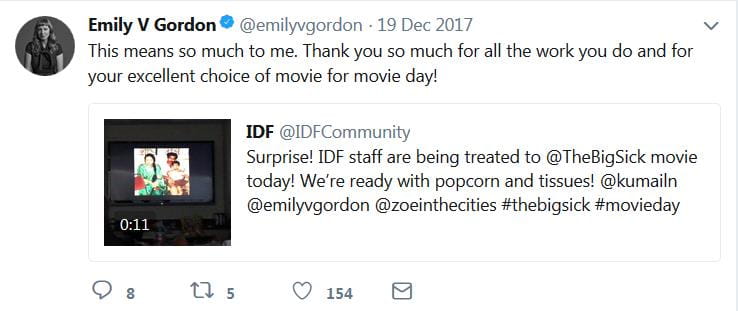Being a patient can be a lonely experience, but a movie that’s done well can show an audience of millions what it feels like to have a serious health problem.
The Immune Deficiency Foundation, which advocates for patients with primary immunodeficiencies (PI), recently decided to show its staff the award-winning movie, “The Big Sick.” The film, based on the real-life experience of Emily V. Gordon and comedian Kumail Nanjiani, chronicles Emily’s deteriorating health and the agonizing weeks when doctors did not know what was wrong with her.
“This honest and moving film shares the story of what many of our patients experience when dealing with an unknown disease for the first time,” the IDF said on its Facebook page.
That gave us an idea. We asked members of our patient community to think about all the movies that have portrayed patients. Which got the patient experience right? Which ones missed the mark? Here’s what they said:
Hector Grisalez, whose son has hemophilia, said he liked “The Fault in Our Stars,” a movie based on a John Green novel about two teenage cancer patients who fall in love.
“It was full of support and the struggles that they faced with an illness, not to mention awesome parents,” Grisalez said.
Another patient also singled out “The Fault in Our Stars” for how it depicted “fear, heartache and the anxiety of diagnosis.”
Lynne Doebber reached back a few years and chose “Lorenzo’s Oil,” a popular film from 1992. It depicted the real-life struggle of parents whose young son has a rare neurological disease known as adrenoleukodystrophy, or ALD. Frustrated with the lack of research and options for their child, the parents mounted their own effort to investigate the disease and even developed a potential remedy, Lorenzo’s Oil.
“The parents never gave up and were their son’s advocate,” Doebber said.
Margaret Mary Conger, a senior patient engagement associate at CSL Behring, chose “Steel Magnolias.” The 1989 film explored the joys and struggles of a group of southern women, including Julia Roberts as a young mother who develops diabetes-related kidney failure. The support and loyalty of the character’s mother, played by Sally Field, made the movie memorable, Conger said.
“I think it got the caregiver’s perspective right by showing how hard it is to strike a balance between letting your child with a chronic condition grow and transition into an adult,” she said.
This 1991 weeper, also starring Julia Roberts, examined the relationship between a nurse and the terminally ill man she’s caring for. Machelle Pecoraro recommends it because “it does a great job at handling the anger and self-pity chronically sick patients and their loved ones face.”
Diane Dimon singled out “Wonder,” a movie released in 2017 and based on the popular book by R.J. Palacio. “Wonder” follows the middle school journey of Auggie Pullman, who has facial differences due to the rare condition Treacher Collins Syndrome.
“It tells an honest and sweet story about empathy, acceptance, kindness, and friendship,” she said. “I especially like how the characters model exceptional behavior that we might all emulate – whether we live with diseases/disabilities or not.”
A Few Films That Fell Short
While many films got a big thumbs up, others got a big thumbs down. Patient Melaine Zeigler was not a fan of 2017’s “Everything, Everything” about a teen girl who has a severe primary immunodeficiency (or does she?). The movie rankled the IDF community and others, sparking debate about whether movies have a responsibility to be medically accurate and sensitive to people who have the disease in real life.
In the film (spoiler alert), the main character turns out not to have the real disease, severe combined immunodeficiency (SCID). Rather, she’s been a victim of her mother’s desire to make her sick, a syndrome known as (Munchausen by Proxy). This plot device was a particularly poor choice, the IDF said, because so many patients who really do have immunodeficiencies struggle to get a diagnosis and many have been labeled as hypochondriacs.
The release of “Everything, Everything” prompted the IDF to release a statement saying it was “surprised and saddened that director Stella Meghie’s version continues Hollywood’s trend of erroneously misrepresenting this condition through worn stereotypes and misinformation.” The film added new misunderstandings to those created by 1979’s TV movie, “The Boy in the Plastic Bubble,” the IDF said.
More recently, the children’s movie, “Peter Rabbit,” came under fire for the way it portrayed a character who has a food allergy. Parents complained loudly on social media and Sony Pictures issued an apology.
Could “The Big Sick” Win an Oscar?
Where “Everything, Everything” failed, “The Big Sick” succeeded, Zeigler said. She liked how the movie dealt with the surprises and hardships of an unknown illness, “especially when it’s a diagnosis out of the blue.”
While “The Big Sick”’s Emily Gordon was in a medically induced coma, her parents and future husband Kumail Nanjiani were left to wonder if she would ever recover. Thankfully, she did. The real Gordon was diagnosed with Adult Onset Stills Disease, a rare inflammatory disorder.
She was also later diagnosed with chronic variable immune deficiency (CVID), which is among the more than 300 primary immunodeficiencies. Gordon took notice when the IDF held the special movie screening for its staff in December.

“This means so much to me. Thank you so much for all the work you do and for your excellent choice of movie for movie day” she said via Twitter. Gordon later sat down for a chat with IDF President and CEO John Boyle.
She and Nanjiani are currently nominated for an Oscar for original screenplay. Watch on March 4 to see if they win.
Two Smaller Films That Made the Grade
We’ll end with two movies that maybe didn’t come to your local cineplex, but our patients say are worth watching nonetheless. Special Blood is a 2016 documentary about hereditary angioedema (HAE), a rare disease that causes dangerous swelling attacks. The film, which was screened around the world at film festivals and special events, came recommended because it features real patients and caregivers.
Our final film recommendation is “Alice’s Story,” which was recommended by – you guessed it – Alice herself. Alice Wilson, a patient who has the rare lung disorder alpha-1 antitrypsin deficiency, recommended this mini-film because she says it accurately portrays her life experience as a patient and Alpha-1 advocate. There’s plenty of other stuff on YouTube that gets the patient experience very wrong, Wilson said.
CSL Behring made the three-minute video to share Alice’s journey from misdiagnosis to outspoken advocate for testing. We filmed it at a farm, where she works part-time. Listen to hear which of the farm animals got the opening line.



